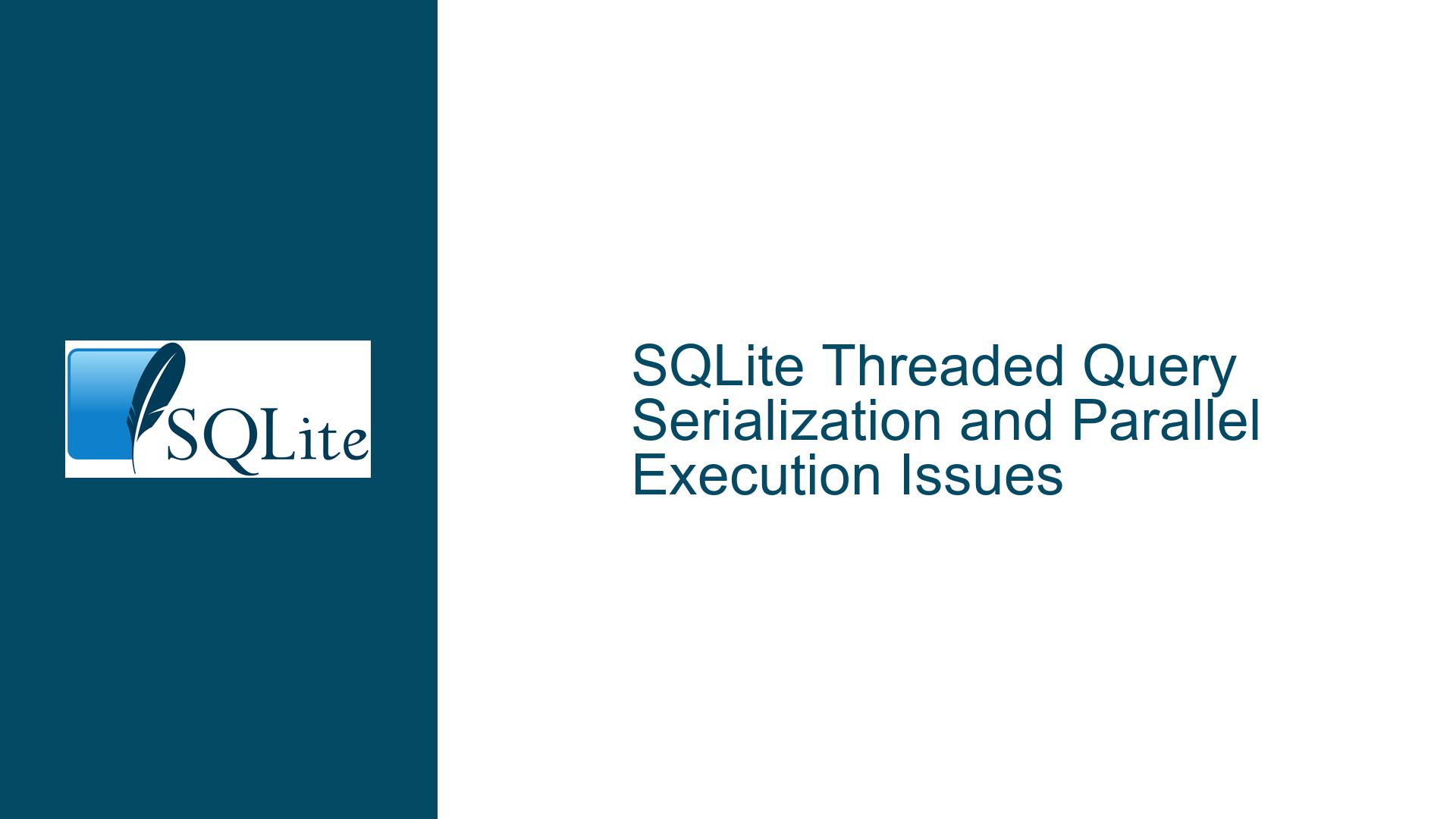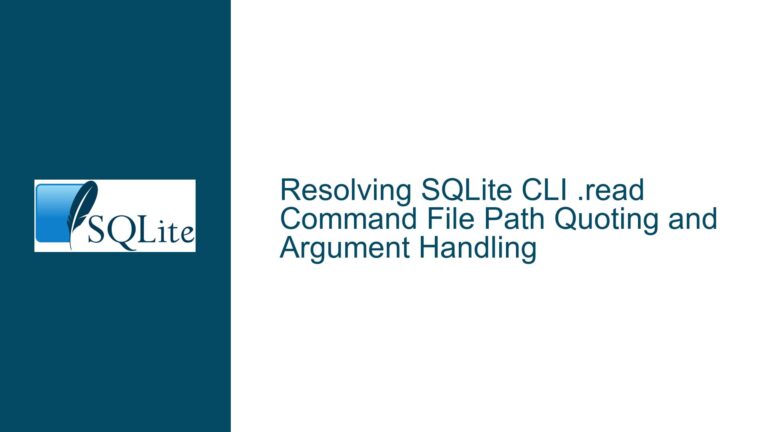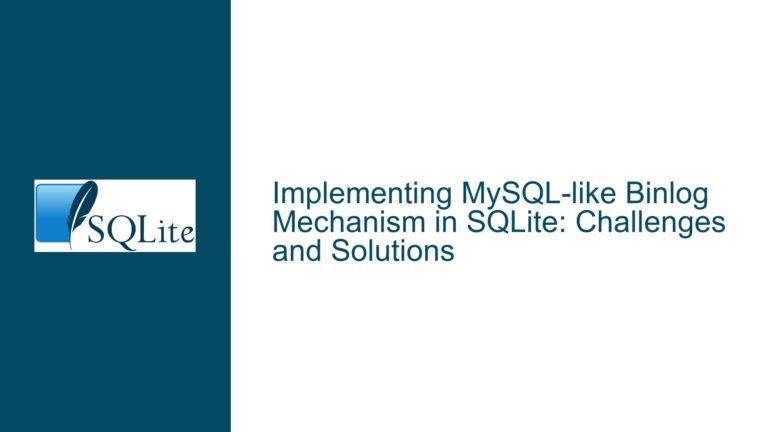SQLite Threaded Query Serialization and Parallel Execution Issues
SQLite’s Thread-Safe Query Execution and Parallelism Constraints
SQLite is a lightweight, serverless database engine that is widely used in applications where simplicity, portability, and low resource consumption are critical. However, its design philosophy and implementation details impose certain constraints on how queries are executed in multi-threaded environments. This post delves into the core issue of query serialization in SQLite when multiple threads attempt to execute queries concurrently, explores the underlying causes, and provides detailed troubleshooting steps and solutions to optimize performance in such scenarios.
Understanding SQLite’s Thread-Safe Query Execution Model
SQLite is designed to be thread-safe, but this thread safety comes with specific limitations that can impact the performance of multi-threaded applications. At the heart of this issue is SQLite’s use of mutexes to protect critical data structures and ensure that only one thread can access a connection at a time. This design choice is rooted in SQLite’s commitment to data integrity and simplicity, but it can lead to unexpected serialization of queries when multiple threads share a single database connection.
When a multi-threaded application shares a single SQLite connection across threads, SQLite enforces serialized access to the connection. This means that only one thread can execute a query at any given time, while other threads must wait for their turn. This behavior is often misinterpreted as a lack of parallelism in SQLite, but it is actually a deliberate design choice to prevent data corruption and ensure thread safety.
The serialization of queries becomes particularly noticeable when long-running queries are executed in parallel. For example, if a thread executes a query that takes one second to complete, other threads attempting to execute queries on the same connection will be blocked until the first query finishes. This can lead to significant performance degradation in applications that rely on high concurrency.
To mitigate this issue, SQLite provides the Write-Ahead Logging (WAL) mode, which allows multiple readers to operate concurrently while a single writer is active. However, even in WAL mode, the serialization of queries within a single connection remains a bottleneck. This is because the mutexes protecting the connection’s internal state are still in effect, ensuring that only one thread can interact with the connection at a time.
Causes of Query Serialization in Multi-Threaded Applications
The primary cause of query serialization in SQLite is the sharing of a single database connection across multiple threads. Each SQLite connection maintains its own internal state, including prepared statements, transaction contexts, and cursor positions. To protect this state from concurrent modifications, SQLite uses mutexes to enforce serialized access to the connection.
When multiple threads attempt to execute queries on the same connection, they are forced to wait for the mutex to be released by the thread currently using the connection. This results in a sequential execution of queries, even if the queries are read-only and could theoretically be executed in parallel.
Another contributing factor is the Global Interpreter Lock (GIL) in Python, which can further exacerbate the issue by serializing access to Python objects and data structures. While the GIL is not directly related to SQLite’s internal mechanisms, it can interact with SQLite’s thread-safety model to create additional bottlenecks. For example, if a Python application uses a thread pool to execute SQLite queries, the GIL may prevent multiple threads from running Python code simultaneously, even if each thread has its own SQLite connection.
Additionally, SQLite’s default memory allocation statistics collection can introduce overhead and contention in multi-threaded environments. When memory statistics are enabled, SQLite uses additional locks to track memory usage, which can increase the likelihood of contention and serialization. Disabling memory statistics by compiling SQLite with the SQLITE_DEFAULT_MEMSTATUS=0 flag can reduce this overhead and improve performance in some cases.
Optimizing SQLite for Parallel Query Execution in Multi-Threaded Applications
To achieve parallel query execution in SQLite, it is essential to understand and work within the constraints of its thread-safety model. The following steps outline strategies for optimizing SQLite performance in multi-threaded applications:
Use Separate Database Connections for Each Thread: The most effective way to enable parallel query execution in SQLite is to assign a dedicated database connection to each thread. This ensures that each thread can execute queries independently, without being blocked by other threads. When using a thread pool, it is important to maintain a pool of database connections that matches the number of threads in the pool.
Enable Write-Ahead Logging (WAL) Mode: WAL mode allows multiple readers to operate concurrently while a single writer is active, improving concurrency and reducing contention. To enable WAL mode, execute the following command on the database:
PRAGMA journal_mode=WAL;. This change is persistent and will take effect for all subsequent connections to the database.Disable Memory Allocation Statistics: If memory allocation statistics are not required, consider compiling SQLite with the
SQLITE_DEFAULT_MEMSTATUS=0flag to disable them. This reduces the overhead associated with tracking memory usage and can improve performance in multi-threaded environments.Minimize Python GIL Contention: To reduce the impact of the Python GIL, consider restructuring the application to minimize the amount of Python code executed in parallel threads. For example, preloading data into memory with a single query and performing filtering and processing in the application layer can reduce the need for highly parallel queries.
Test Under Realistic Conditions: When optimizing SQLite for multi-threaded applications, it is crucial to test under conditions that closely mimic real-world usage. This includes simulating the expected concurrency levels, query patterns, and operating conditions. Thorough testing can help identify bottlenecks and ensure that the application performs reliably under load.
Consider Alternative Concurrency Models: If the application’s concurrency requirements exceed SQLite’s capabilities, consider using a different database engine that is designed for high concurrency, such as PostgreSQL or MySQL. These databases offer more advanced concurrency control mechanisms and can handle higher levels of parallelism.
By following these steps, developers can optimize SQLite for parallel query execution in multi-threaded applications while maintaining data integrity and thread safety. While SQLite’s design imposes certain limitations, understanding and working within these constraints can lead to significant performance improvements and a more responsive application.






